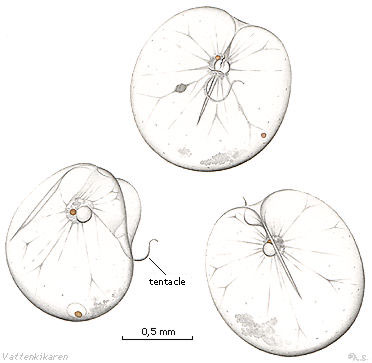
Distribution in scandinavian waters |
Maximum diameter: Approx. 2 mm, but seldom more than 1 mm in
Scandinavian waters. Compare
the size with a hair.
Appearance: Seasparkle is almost completely colourless and transparent,
but when driven together in large numbers the water can appear thick
and have a light brown to pink colour. The cell is relatively large
and round and is furnished with three protrusions. Two of the protrusions
are small and vague and can easily be believed to correspond to the
mobile cell outgrowths on other dinoflagellates. The third protrusion,
that is unique for seasparkle and known as a tentacle, is striped and
much more pronounced than the others. All the protrusions are situated
in a large deep groove on the underside of the cell.
In the picture above, the picture at the top depicts seasparkle
from its underside, the left-hand picture depicts the right side of
seasparkle, while the right-hand picture depicts it from above.
Depth: Seasparkle is most common in the upper reaches of the
sea that recieves sunlight.
Environment: Pelagic.
Misc: Seasparkle is so large because it pumps itself up with
water. By regulating the amount of ions
it can effect its bouyancy and towards the end of the bloom they usually
congregate at the surface.
In the large cells, thousands
of small reproductive bodies can be formed.
With the help of its tentacle seasparkle collects its
food, which can be of the same size as itself, and carry it to its mouth
which is situated at the bottom of the groove. Coloured particles seen
in the cell are often particles of food or small photosynthesizing organisms
that live together with the seasparkle.
Seasparkle is one of those organisms that cause phosphorescence
of the sea in our waters!
Classification: Sea sparkle belongs to the dinoflagellate group
under the "protists". The protists as a systematic group is not well
motivated or defined, as it is used to collect organismer that are not
bacterias, fungi, plants or animals into a common group.
|



